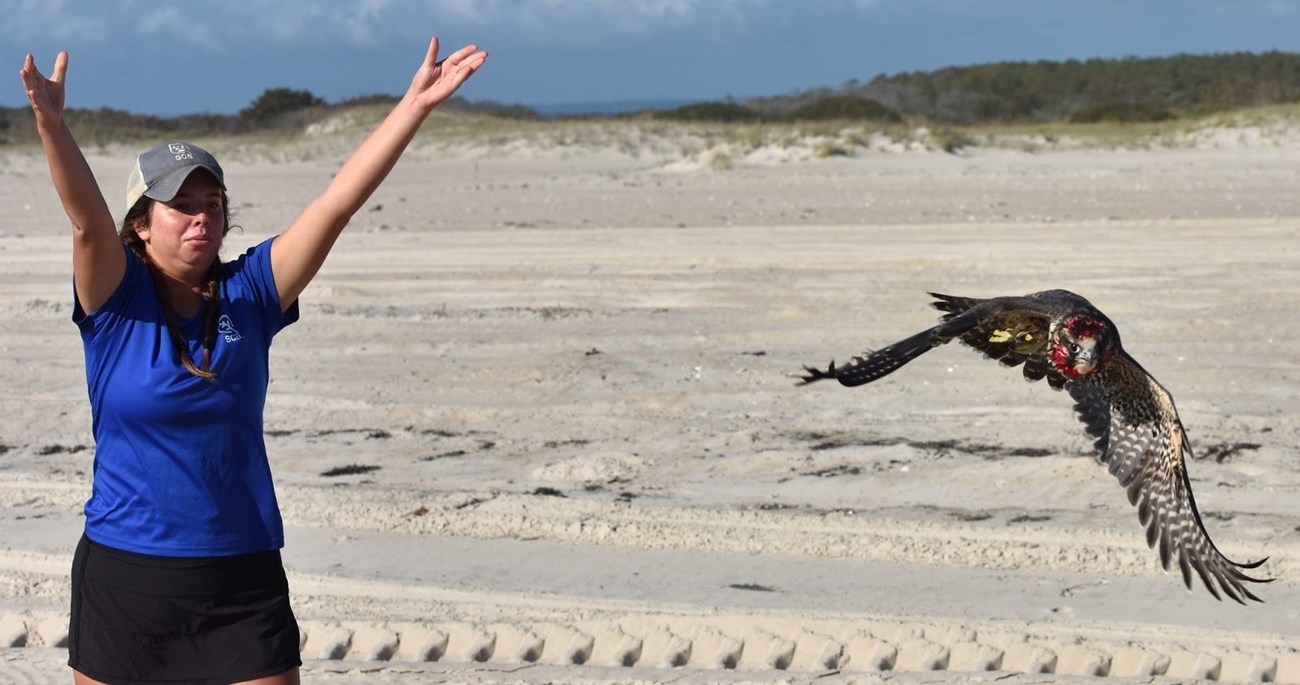Part of a series of articles titled Northeast Coastal and Barrier Network Species Spotlight.
Article
Northeast Coastal and Barrier Network Species Spotlight: Peregrine Falcon

NPS ASIS
Background
Peregrine falcons (Falco peregrinus) are the fastest member of the animal kingdom, reaching dive speeds greater than 200 mph. They are a large member of the falcon family with a wingspan of 3.5 feet. Like other raptors, peregrine falcons are sexually dimorphic with adult females growing larger than males. Juvenile coloration varies widely between light-colored markings to heavily-and-darkly markings with a dark brown cap. That being said, juvenile peregrines can be categorized as being some shade of tan or brown. Characteristic adult plumage is marked by dark gray upper wings, crown, and a unique dark “mustache” around the beak. Underwings display a uniform gray-and-white pattern. Peregrine falcons are widely distributed, found on every continent except Antarctica. They prefer to nest on cliffs and ledges, but will use urban structures including transmission towers, skyscrapers, and bridges. Peregrine falcons primarily prey on birds, and have been documented feeding on at least 450 different bird species. While certain populations are resident, others migrate up to 15,000 miles annually to winter in warmer climates. The migratory route of many tundra peregrine falcons passes directly over Assateague Island. While it is rare for peregrines to nest on this barrier island, the undisturbed beaches and expansive coastal dune habitats provide an ideal resting stop during fall migration. Therefore, Assateague Island provides scientists with an ideal location to conduct long-term research studies on these traveling birds of prey.

NPS ASIS
Status and Trends
Widespread use of the pesticide dichloro-diphenyl-trichloroethane (DDT) after World War II resulted in sharp declines of the peregrine population. Chemicals ingested by prey animals accumulated in the tissues of the falcons, causing a cascade of reproductive health problems including the formation of thin eggshells. In 1970, the peregrine falcon was federally listed as an endangered species. During a renewed period of conservation efforts to help restore bird populations, the Department of the Army initiated a research program to develop new technologies to help monitor highly migratory wildlife species. As part of this effort, researchers established an annual peregrine falcon survey at Assateague Island National Seashore nearly 50 years ago.
During each survey, all raptors observed are recorded according to species, time, location and activity at the time of sighting. Accessible peregrines are captured, banded, processed according to current protocols, and then released. Approximately 20,000 peregrine falcons have been counted during the Assateague survey with an additional 5,746 captured for scientific research. Over the years, this survey program has expanded to include other natural history aspects of the peregrine, including global contaminant issues, emerging pathogens and genetics.

NPS ASIS
A mercury contamination study was recently completed using feathers that were collected from Assateague peregrines during autumn migrations between 2009-2015. As tertiary consumers, raptors are susceptible to biomagnification of environmental pollutants. Results showed mean concentrations of total mercury in adult peregrines have increased from 4.45 mg/g (historically) to just over 10 mg/g. Long term monitoring and research will continue to expand our understanding of peregrine falcons and how they interact with their environment.
Fifty years of survey data from Assateague Island illustrate that peregrine population levels have rebounded. As a result, the migratory peregrine subspecies (F. tundrius) studied at Assateague was removed from the Endangered Species list in 1994. A few years later in 1999 the continental peregrine (F. p. anatum) was delisted as well. In the last decade there has been a slight decrease in the number of falcons sighted at Assateague Island. Researchers believe this may be due to increases in severe weather systems, human presence and development along the coast, and an increase in the amount of bald eagles present on the beachfront at Assateague. In particular, bald eagles tend to behave aggressively towards peregrine falcons. Because of this, peregrines may be trading Assateague for safer beachfront elsewhere. This decrease does not necessarily signal cause for concern, as populations remain stable across the region. This research study is now one of the longest running studies of peregrine falcons in the Americas which underscores the importance of barrier islands as critical habitat for rare species along the Atlantic Flyway.
Written by Edward Cascella, Geoscientists-in-the-Parks (GIP) Intern
Last updated: April 9, 2023
